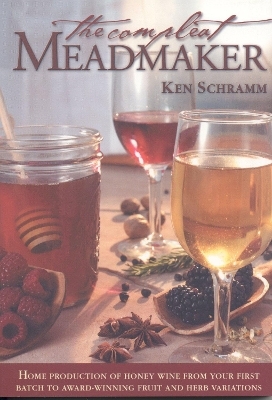
The Compleat Meadmaker
Brewers Publications (Verlag)
978-0-937381-80-9 (ISBN)
Since The Compleat Meadmaker was first published, mead has continued to grow in popularity as crafted beverages have become an established part of the beverage market in America. In 2003 there were roughly 60 commercial meaderies in the US, but by 2020 this number stood at 450. Naturally, many hobbyists are also discovering the delights of making this “nectar of the gods” themselves. Thanks to the global distribution of bees and, therefore, honey, you will find mead-like drinks in virtually every corner of the world. No wonder historians recognize it as one of humankind’s oldest fermented beverages. Mead production never really ceased in Europe and Africa, but its star was eclipsed with the increasing production and distribution of wine, beer, and distilled spirits from the 1600s onward. With the rebirth of brewing and the establishment of world-class wine producing regions in the US, it is time for mead in the twenty-first century to be brought back into the limelight. Mead needs to establish a vocabulary of its own and find a place in the hearts of homebrewers and home winemakers.
In The Compleat Meadmaker, veteran meadmaker Ken Schramm—one of the founders of the Mazer Cup Mead Competition, North America’s oldest mead-only competition—introduces the novice to the wonders of mead. With easy-to-follow procedures and simple recipes, he shows how you can quickly and painlessly make your own mead at home. In later chapters, Schramm introduces flavorful variations on the basic theme that lead to meads flavored with spice, fruits, grapes, and malt.
The author covers the many aspects of meadmaking in a comprehensive but easy-to-read fashion, with something for novices and experienced brewers and vintners alike from basic equipment for meadmaking, creating your first must, and on through the basics of fermentation, racking, and bottling. Once the first steps have been taken Schramm goes into more detail, involving balancing for taste using acid, priming for sparkling mead, corking practices, and strategies for clarifying. He also covers aspects of fermentation, such as selecting the right yeast strain, aerating and managing the pH of your must during the critical early phase of fermentation, and adjusting nutrient levels to suit mead fermentation. The author also troubleshoots common problems and processes, such as stuck fermentations, fermentations that will not start, slow or prolonged fermentations, measuring total acidity via acid titrations, and on balancing residual sugars through sweetening, malo-lactic fermentation, increasing acidity, and drying out the mead further. The fine-tuning process does not stop after fermentation is finished. Perhaps the finest characteristic of mead is that it seems to improve with age almost indefinitely. As well as advice on how long to store it, Schramm also offers up his experience with the many different approaches to conditioning and maturing mead, focusing on the use of oak chips, blocks, and barrels to age mead on wood.
As one of the oldest fermented drinks and using the oldest sweetener known to humankind, mead and honey are inextricable. Schramm delves into a brief natural history of honey production and the bees that make it possible, with fascinating insights into the profession of beekeepers. He explores sources of nectar and pollen and the benefits of honey varietals explored, with a section devoted entirely to varietal honey based on floral variety. Along the way Schramm delves into the concept of honey “vintage”, grades of honey, sugar, moisture, organic acids, mineral content, color terminology, and how you should not judge a honey’s flavor by its color. There is also a discussion of aroma compounds, absolutely essential if wishing to understand the organoleptic qualities of honey.
While mead can be a charmingly simple drink to make, home meadmakers can easily indulge in a host of different flavors to make unique and delicious meads. The author provides you with an understanding of the role quality ingredients play in creating a really pleasing mead. There are several ingredients-focused chapters that look at making sack mead, melomel, cyser, pyment, hippocras, metheglin, and braggot. At the end, Schramm puts it all together in a section devoted entirely to recipes.
As one of the most ancient of human beverages, mead arose in part because it was easy to make. Despite this, mead is a surprisingly complex, diverse, and romantic drink that can range from bone dry to profoundly sweet, and can be crafted to complement any type of food. With The Compleat Meadmaker, you can see just how simple, fun, and rewarding meadmaking is.
Ken Schramm is a mead maker, musician, fruit grower, baker, brewer, hunter, angler, fly tyer and lover of all things gustatory. He is the author of The Compleat Meadmaker (Brewers Publications, 2003), and has been involved in beverage hobbies since 1988. He has served on the AHA Board of Advisers, and is one of the founders of the Mazer Cup Mead Competition, North America's oldest mead-only competition. Ken opened Schramm's Meadery in Ferndale, MI in 2013. Ken lives in Troy, Michigan with his wife, Jean.
Table of Contents
Acknowledgements
Foreword
Part One: Background
1. From the Beginning to a Modern Revival
2. Defining the Styles
Part Two: Process
3. Changing Honey into Wine
4. Beyond the Basics
5. Yeast and Fermentation
6. Conditioning, Aging, and Using Oak
Part Three: Ingredients
7. All About Honey
8. Fruit and Melomel
9. Grapes and Pyment
10. Spices and Metheglin
11. Grains and Braggot
Part Four: Recipes
12. Putting the Process and Ingredients Together
13. Appreciating Your Mead
Appendix 1: Honey and Other Suppliers
Appendix 2: Conversion Charts
Glossary
Bibliography
Index
| Erscheint lt. Verlag | 29.7.2003 |
|---|---|
| Verlagsort | Boulder, CO |
| Sprache | englisch |
| Maße | 180 x 256 mm |
| Gewicht | 431 g |
| Themenwelt | Sachbuch/Ratgeber ► Essen / Trinken ► Getränke |
| ISBN-10 | 0-937381-80-2 / 0937381802 |
| ISBN-13 | 978-0-937381-80-9 / 9780937381809 |
| Zustand | Neuware |
| Haben Sie eine Frage zum Produkt? |
aus dem Bereich


